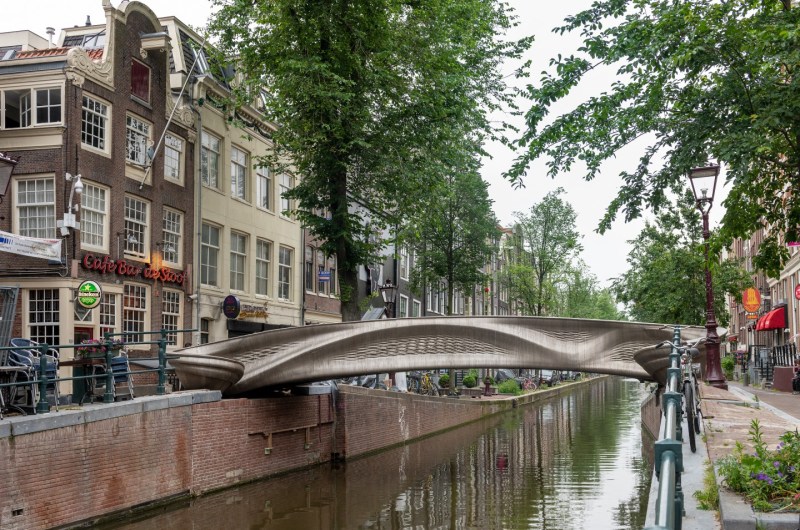Way back in 2018, we brought you news of a 3D-printed stainless steel pedestrian bridge being planned to span a Dutch canal in Amsterdam. Now it’s finally in place and open to the public — the Queen made it official and everything. MX3D printed it on their M1 Metal additive manufacturing machine that is essentially a group of robots welding layers of metal together using traditional welding wire and gas.
The partnership of companies involved originally planned to build this beautiful bridge in situ, but safety concerns and other issues prevented that and it was built in a factory instead. The bridge has been printed and ready since 2018, but a string of delays got in the way, including the fact that the canal’s walls had to be refurbished to accommodate it. Since it couldn’t be made on site, the bridge was taken there by boat and placed with a crane. After all this, the bridge is only permitted to be there for two years. Hopefully, they have the option to renew.
This feat of engineering spans 40 feet (12.2 meters) long and sits 20 feet (6.3 meters) wide. It’s equipped with sensors that measure structural stuff like strain, displacement, load, and rotation, and also has environmental sensors for air quality and temperature. All of this data is sent to the bridge’s digital twin, which is an exact replica in the form of a computer model. One of the goals is to teach the bridge how to count people. Be sure to check out our previous coverage for a couple of short videos about the bridge.
















You forgot to mention that bridge opens a new pedestrian path to Amsterdam’s famous Red Light District. It will count people who go there, the people who come back and also measure different…. parameters.
Sorry to disappoint you, but the red light district is no more. It is a tourist trap now. Only a few places remain of the once complete occupied district.
On that bridge it is (or it should be) written in Latin: “Futeo, non futeo, tempus pullum ireparabile fugit”. That inscription was found in the city of Pompei in one of the same famous districts.
Nice!
Anyone knows the cost? It says they used 6,000kg of stainless steel (I assume the net finished weight is pretty close to the gross amount?), and I also assume that since complexity comes “free”, then the £/kg would remain constant across applications.
Nice! I think I walked over this bridge already in the Dutch Design Week 2019, in Eindhoven.
The bridge looks cool, but I wanna see a video of that bloody printer!
https://youtu.be/v2moJF8kqIg
I can’t wait to thin sections of the interlayers after exposure to the elements for a while. Stainless is subject to some unusual corrosion scenarios and the bridge is effectively a massive set of crevices and possibly a few other passivation failures waiting to happen.
I’d have nickel plated the entire thing just to be sure.
You nailed it. I doubt a consultant with fracture mechanics knowledge was involved here. You have literally tons of cracks in this thing.
And Bender says “Dutch is my favorite kind of canal in Amsterdam!”
It looks really really nice… but honestly I’m only mildly interested in the end result.
One of the questions I have is, how much work did the cleanup process take? Because none of the things I print are ready when the printer has finished. And did they apply some coating to keep it shiny?
It’s *stainless steel*.
The bridge is only there to stay for 2 years as it is only temporarily replacing a classic bridge that is being refurbished. It may be reused at another location in the future though.
I hope people mess with their sensors by jumping up and down on the bridge.
What is the infill percentage?
For a municipal project like a public bridge, 6 months is nothing. Considering the labor costs are almost nothing when compared to having to build it the traditional way, the cost comparison should be obvious. Instead of paying a dozen union guys for months worth of 9-5 work, you’ve got a handful of people monitoring the printer doing it’s thing 24/7.
It’s not months of work to weld & bolt together a simple steel pedestrian bridge.
Looks cool and all but I really struggle to believe that 3D printing structures like this, or even with concrete goo, is actually faster or more efficient than more tradtional methods for 99% of applications.
The electricity + gas bill alone for running a MIG robot at full chat for thousands of hours must be huge compared to a few big lumps of mass-produced steel from a mill being cut & welded to shape.
Killjoy! The only way we can make any progress is by trying new things. This iteration of the process might not be optimal, but we’ll learn something from it and might be able to apply that to future projects (and not only bridges). Little has been gained by doing the same things in the same way forever.
That thing is hideous.
Ugly looking, although I’m pretty sure H. R. Gigier would approve.